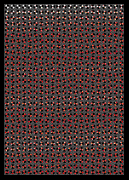 “ “
| Layering” is
the term used by April Greiman in Hybrid Imagery to describe
her landmark style of building complex collages of digital images,
symbols, and type in a manner that has been emulated worldwide.
High-tech “grafitti” is the less flattering word that
Paul Rand in Design, Form, and Chaos uses to describe what
he sees as an unprincipled neo-Dada trend that leads to nowhere.
Although recently we see a rise in criticism fired between the computer-illiterate
past and the computer-empowered present, no professional designer can deny that
quality issues aside, the computer drastically minimizes the effort required
to produce deliverable designwork. As a result, competence with computer-aided
design software has become a basic prerequisite to entering any modern design
firm, where God-like status is bestowed upon so-called tatsujin (gurus)
of the suite of desktop publishing software. However, in contrast to the past
when a skill was some-thing acquired over years of arduous practice, mastering
digital design requires nothing beyond rote memorization of keystrokes and command
sequences. Due to this over-trivialization of many design skills, an increasing
number of non-designers, including children, can now effortlessly set type in
Helvetica, manipulate photographs, and draw perfectly straight lines with the
exact same tools of the professional designer. Of course, work by an amateur
cannot compare to the quality and craftsmanship of the professional, but improved
tools will ultimately close the gap such that only a trained eye can perceive
a difference.
Complexity is the key to writing the next chapter in graphic design.
We can easily verify this in any award-winning digital graphic designwork,
where the metric
of quality is the number of lines, colors, and hours of CPU-time used. I myself
experimented with visual complexity by writing PostScript programs that generated
ultra-complex digital illustrations, as shown in the full-page image that accompanied
the previous article entitled “Time Graphics.” After gaining confidence
in manipulating complex two-dimensional image spaces, I added another dimension
- time, and proceeded to explore the complexity of infinity. However, as I quickly
learned, unbounded expressive spaces that change with respect to time make exciting
play, but inadequate communicative design. I then proceeded to strengthen the
viewer's involvement with the time form, and began to create “reactive” graphics,
visual experiences that respond to user input in realtime in a way that defies
physics (not virtual reality) and are devoid of content (not interactive media
in the ordinary sense). In my recent book The Reactive Square, I presented an
introduction to this style of digital graphicwork with 10 different squares that
react to sound. A model of a pinwheel that illustrates this concept is included
in the accompanying CD-ROM.
 |
The
download described in this essay is available [here].
It is designed to run on a pre-OSX Macintosh for a resolution
of 640 by 480 pixels. There is no guarantee that it runs
any longer.
|
|
